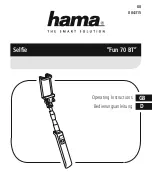
Because of their heavy duty and specialized blade designs we do not recommend the
Model 15 for the very thick European cleavers or the heavy hunting knives with concave
blade faces. These can be readily sharpened in Models 120, 130, 2000, and 2100. The
Model 15 is ideal for sharpening Asian cleavers and fish fillet knives.
Never operate the sharpener from the back side.
Use just enough downward pressure
when sharpening to ensure uniform and consistent contact of the blade edge with the
abrasive disks on each stroke. (See Suggestion 5, page 14). Additional pressure is unneces-
sary and will not speed the sharpening process. Avoid excessive cutting into the plastic
enclosure.Accidental cutting into the enclosure however will not functionally impact operations
of the sharpener or damage the edge.
Try a practice pull through the sharpener before you turn on the power. Slip the knife blade
smoothly into the left slot between the left angle guide of Stage 1 and the plastic knife
holding spring. Do not twist the knife. Move the blade down in the slot until you feel it
contact the diamond disk. Pull it towards you lifting the handle slightly as you approach the
tip. This practice pull will give you a feel for the spring tension. Remove the knife and read
the following instructions specific to the type of knife you will be sharpening.
HOW TO CREATE THE TRIZOR XV™ EDGE ON
EURO/AMERICAN AND CONTEMPORARY ASIAN BLADES
If you have European or American brand knives, it is extremely easy to convert their edge
to the Trizor XV™ (15 degree) edge. The procedure outlined here applies equally to
sharpening contemporary Asian blades. The edge of Euro/American and contemporary Asian
knives are identical in that they are sharpened on both sides of the edge. If you have any
uncertainty about the type of Asian blades you wish to sharpen, refer to their
description on pages 10 and 11. Virtually all Asian blades are factory sharpened at 15 degrees.
5


































